A Case Study Integrating Numerical Simulation and InSAR Monitoring to Analyze Bedding-Controlled Landslide in Nanfen Open-Pit Mine
Abstract
1. Introduction
2. Study Area
2.1. Engineering Geology
2.2. Mining Conditions
3. Methodology
3.1. Monitoring with InSAR
3.2. Numerical Modeling
3.2.1. Numerical Calculation Model
3.2.2. Damage Constitutive Model of Layered Slope
4. Results
4.1. Validation with Monitoring Results
4.2. Numerical Simulation Analysis Results
- (1)
- Before the mining of 298 m–374 m berm
- (2)
- After the mining of 298 m–374 m berm
5. Discussion
5.1. Landslide Mechanism of Nanfen Open-Pit Mine
5.2. Limitations and Future Work
6. Conclusions
Author Contributions
Funding
Data Availability Statement
Conflicts of Interest
References
- Du, S. Method of equal accuracy assessment for the stability analysis of large open-pit mine slopes. Chin. J. Rock. Mech. Eng. 2018, 37, 1301–1331. [Google Scholar]
- Jin, C.; Lu, Y.; Han, T.; Chen, T.; Cui, J.; Cheng, D. Study on refined back-analysis method for stress field based on in situ and disturbed stresses. Int. J. Geomech. 2021, 21, 04021141. [Google Scholar] [CrossRef]
- Le Breton, M.; Bontemps, N.; Guillemot, A.; Baillet, L.; Larose, É. Landslide monitoring using seismic ambient noise correlation: Challenges and applications. Earth Sci. Rev. 2021, 216, 103518. [Google Scholar] [CrossRef]
- Cigna, F.; Bianchini, S.; Casagli, N. How to assess landslide activity and intensity with Persistent Scatterer Interferometry (PSI): The PSI-based matrix approach. Landslides 2013, 10, 267–283. [Google Scholar] [CrossRef]
- Crosetto, M.; Monserrat, O.; Cuevas-González, M.; Devanthéry, N.; Crippa, B. Persistent scatterer interferometry: A review. ISPRS J. Photogramm. Remote Sens. 2016, 115, 78–89. [Google Scholar] [CrossRef]
- Lubis, A.M.; Sato, T.; Tomiyama, N.; Yamanokuchi, T. Ground subsidence in Semarang-Indonesia investigated by ALOS–PALSAR satellite SAR interferometry. J. Asian Earth Sci. 2011, 40, 1079–1088. [Google Scholar] [CrossRef]
- Tantianuparp, P.; Shi, X.; Zhang, L.; Balz, T.; Liao, M. Characterization of landslide deformations in three gorges area using multiple InSAR data stacks. Remote Sens. 2013, 5, 2704–2719. [Google Scholar] [CrossRef]
- Yun, H.W.; Kim, J.R.; Yoon, H.; Choi, Y.; Yu, J. Seismic surface deformation risks in industrial hubs: A case study from Ulsan, Korea, using DInSAR time series analysis. Remote Sens. 2019, 11, 1199. [Google Scholar] [CrossRef]
- Bar, N.; Dixon, R. Unveiling unknowns: Practical application of InSAR for slope performance monitoring and risk management across multiple surface mines. Eng. Geol. 2021, 293, 106326. [Google Scholar] [CrossRef]
- Lee, H.; Moon, J.; Lee, H. Activity of Okgye limestone mine in South Korea observed by InSAR coherence and PSInSAR techniques. Remote Sens. 2022, 14, 6261. [Google Scholar] [CrossRef]
- Prati, C.; Ferretti, A.; Perissin, D. Recent advances on surface ground deformation measurement by means of repeated space-borne SAR observations. J. Geodyn. 2010, 49, 161–170. [Google Scholar] [CrossRef]
- Sandwell, D.T.; Price, E.J. Phase gradient approach to stacking interferograms. J. Geophys. Res. Solid. Earth 1998, 103, 30183–30204. [Google Scholar] [CrossRef]
- Ferretti, A.; Prati, C.; Rocca, F. Permanent scatterers in SAR interferometry. IEEE Trans. Geosci. Remote Sens. 2001, 39, 8–20. [Google Scholar] [CrossRef]
- Lanari, R.; Mora, O.; Manunta, M.; Mallorquí, J.J.; Berardino, P.; Sansosti, E. A small-baseline approach for investigating deformations on full-resolution differential SAR interferograms. IEEE Trans. Geosci. Remote Sens. 2004, 42, 1377–1386. [Google Scholar] [CrossRef]
- Samsonov, S.; d’Oreye, N. Multidimensional time-series analysis of ground deformation from multiple InSAR datasets applied to Virunga Volcanic Province. Geophys. J. Int. 2012, 191, 1095–1108. [Google Scholar]
- Prudencio, M.; Van, S.J.M. Strength and failure modes of rock mass models with non-persistent joints. Int. J. Rock. Mech. Min. Sci. 2007, 44, 890–902. [Google Scholar] [CrossRef]
- Shi, W.; Yang, T.; Wang, P.; Hu, G.; Zhu, X.; Xiao, P. Anisotropy analysis method for stability of open-pit slope rock mass and its application. Chin. J. Geotech. Eng. 2014, 36, 1924–1933. [Google Scholar]
- Hart, R.; Cundall, P.A.; Lemos, J. Formulation of a three-dimensional distinct element model—Part II. Mechanical calculations for motion and interaction of a system composed of many polyhedral blocks. Int. J. Rock Mech. Min. Sci. Géoméch. Abstr. 1988, 25, 117–125. [Google Scholar] [CrossRef]
- Min, K.B.; Jing, L. Numerical determination of the equivalent elastic compliance tensor for fractured rock masses using the distinct element method. Int. J. Rock. Mech. Min. Sci. 2003, 40, 795–816. [Google Scholar] [CrossRef]
- Goodman, R.E.; Taylor, R.L.; Brekke, T.L. Closure on a model for the mechanics of jointed rock. J. Soil Mech. Found. Div. 1970, 94, 637–660. [Google Scholar] [CrossRef]
- Liu, H.Y. Hybrid finite-discrete element modelling of dynamic fracture of rocks with various geometries. Appl. Mech. Mater. 2013, 256–259, 183–186. [Google Scholar] [CrossRef]
- Zhou, W.; Li, S.; Zhou, Z.; Chang, X. InSAR observation and numerical modeling of the Earth-dam displacement of Shuibuya Dam (China). Remote Sens. 2016, 8, 877. [Google Scholar] [CrossRef]
- Ma, P.; Cui, Y.; Wang, W.; Lin, H.; Zhang, Y. Coupling InSAR and numerical modeling for characterizing landslide movements under complex loads in urbanized hillslopes. Landslides 2021, 18, 1611–1623. [Google Scholar] [CrossRef]
- Li, H.; Yang, X.; Li, L.; Zhang, Z.; Liu, M.; Yao, T.; Chen, J. Desilicification and iron activation-reprecipitation in the high-grade magnetite ores in BIFs of the Anshan-Benxi area, China: Evidence from geology, geochemistry and stable isotopic characteristics. J. Asian Earth Sci. 2015, 113, 998–1016. [Google Scholar] [CrossRef]
- Torres, R.; Snoeij, P.; Geudtner, D.; Bibby, D.; Davidson, M.; Attema, E.; Potin, P.; Rommen, B.; Floury, N.; Brown, M.; et al. GMES Sentinel-1 mission. Remote Sens. Environ. 2012, 120, 9–24. [Google Scholar] [CrossRef]
- Hoek, E.; Brown, E.T. The Hoek–Brown failure criterion and GSI—2018 edition. J. Rock. Mech. Geotech. Eng. 2019, 11, 445–463. [Google Scholar] [CrossRef]
- Zhu, W.; Tang, C.; Zhao, W.; Teng, J. Numerical simulation on the fracture process of concrete specimen under static loading. Eng. Mech. 2002, 19, 148–153. [Google Scholar]
- Lemaitre, J. A Course on Damage Mechanics; Springer: Berlin/Heidelberg, Germany, 1996. [Google Scholar]
- Zhu, W.; Wei, C.; Tian, J.; Yang, T.; Tang, C. Coupled thermal-hydraulic-mechanical model during rock damage and its preliminary application. Rock Soil Mech. 2009, 30, 3851–3857. [Google Scholar]
- Tang, C.; Li, L.; Li, C.; Ma, T. RFPA strength reduction method for stability analysis of geotechnical engineering. Chin. J. Rock Mech. Eng. 2006, 25, 1522–1530. [Google Scholar]
- Guo, R.; Li, S.; Chen, Y.N.; Li, X.; Yuan, L. Identification and monitoring landslides in Longitudinal Range-Gorge Region with InSAR fusion integrated visibility analysis. Landslides 2021, 18, 551–568. [Google Scholar] [CrossRef]
- López-Vinielles, J.; Ezquerro, P.; Fernández-Merodo, J.A.; Béjar-Pizarro, M.; Monserrat, O.; Barra, A.; Blanco, P.; García-Robles, J.; Filatov, A.; García-Davalillo, J.C.; et al. Remote analysis of an open-pit slope failure: Las Cruces case study, Spain. Landslides 2020, 17, 2173–2188. [Google Scholar] [CrossRef]

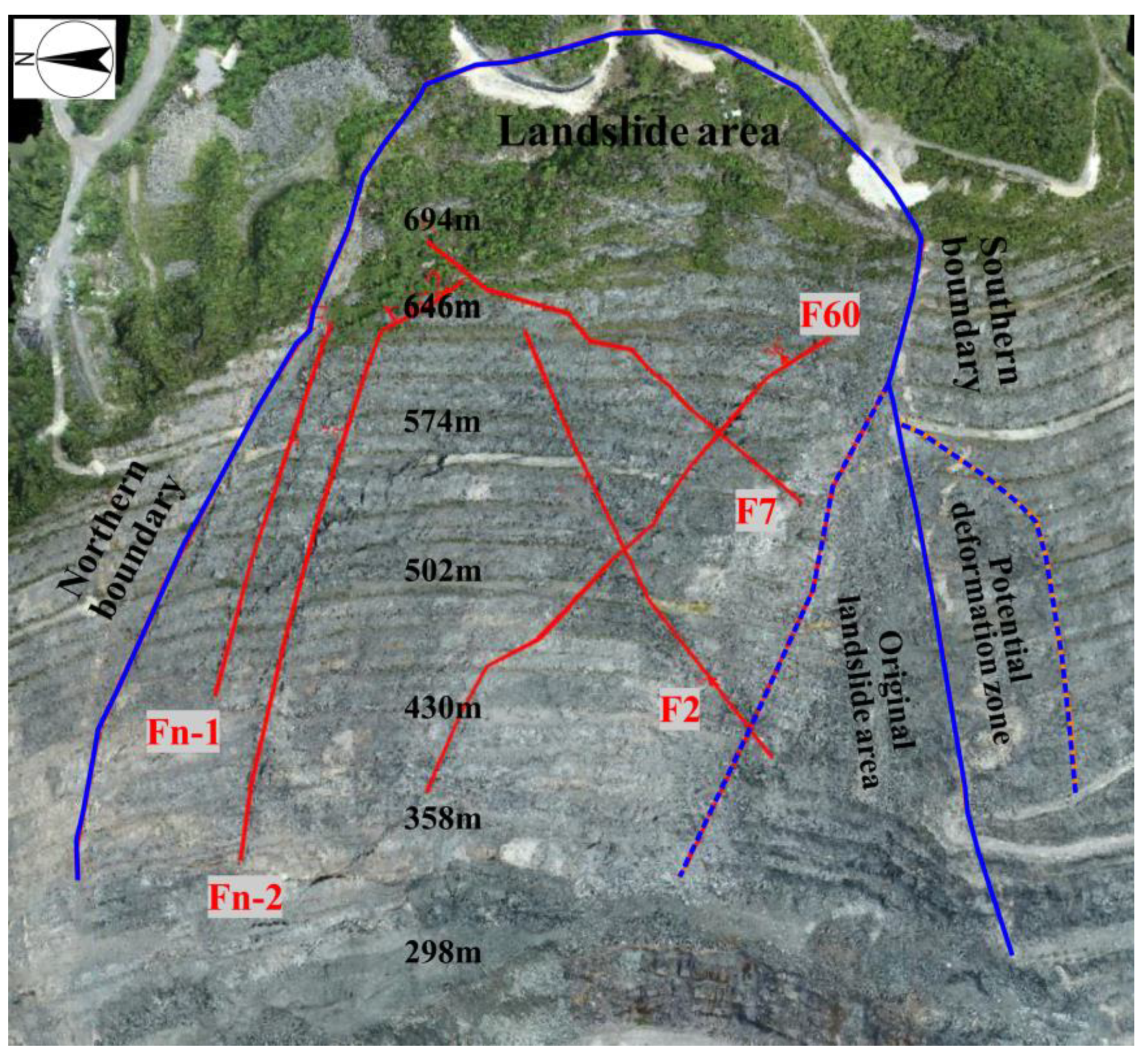
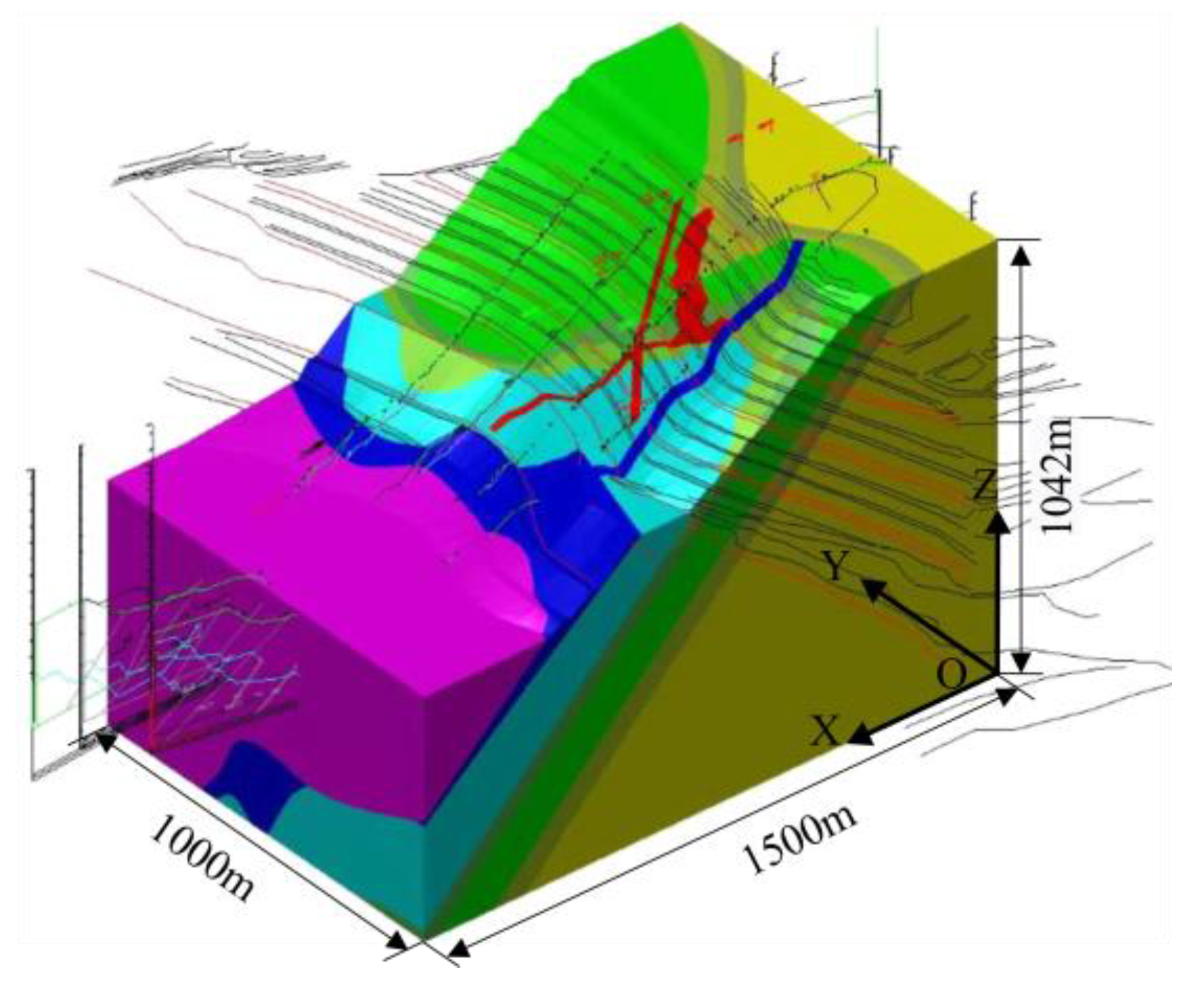
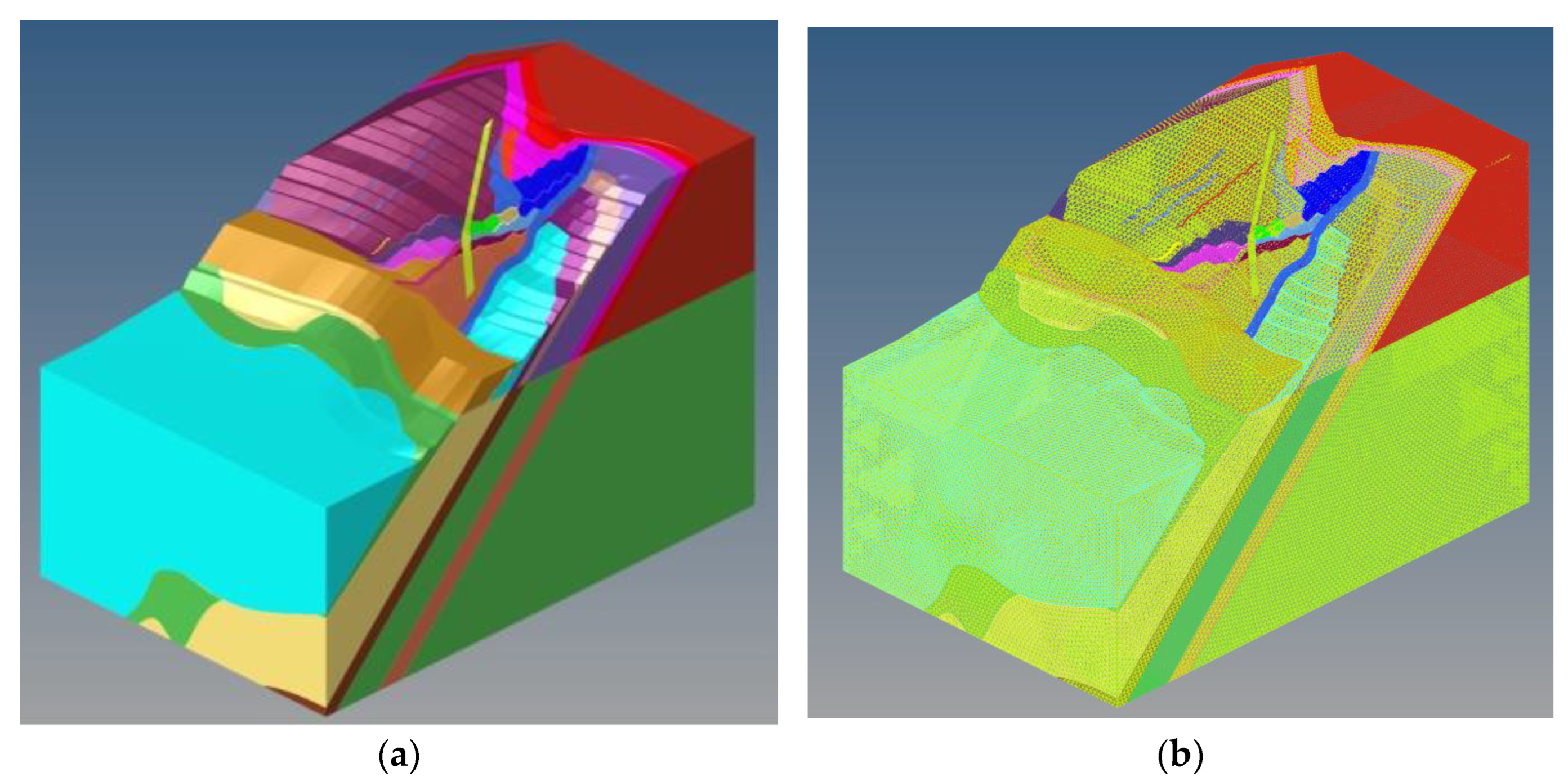

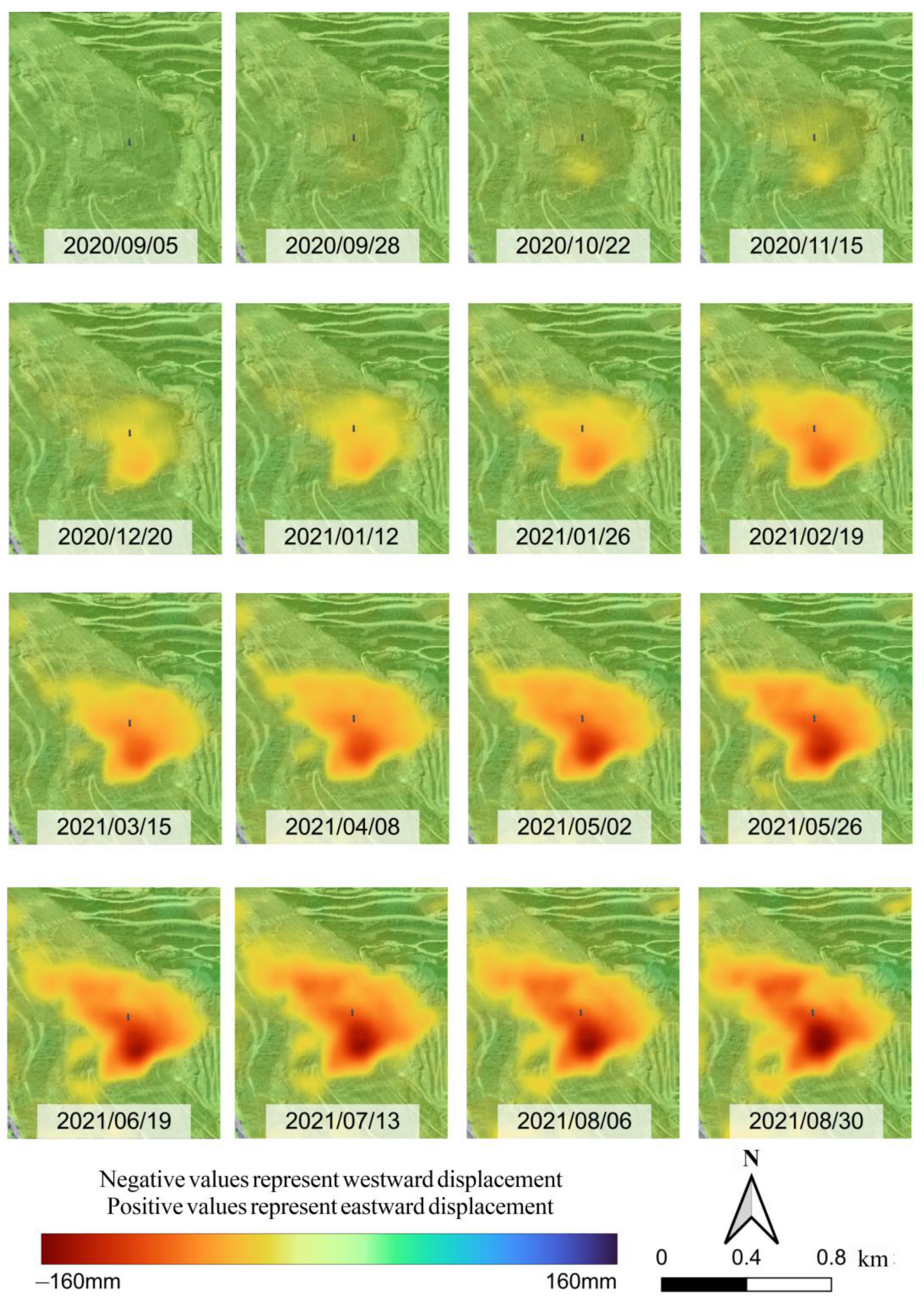
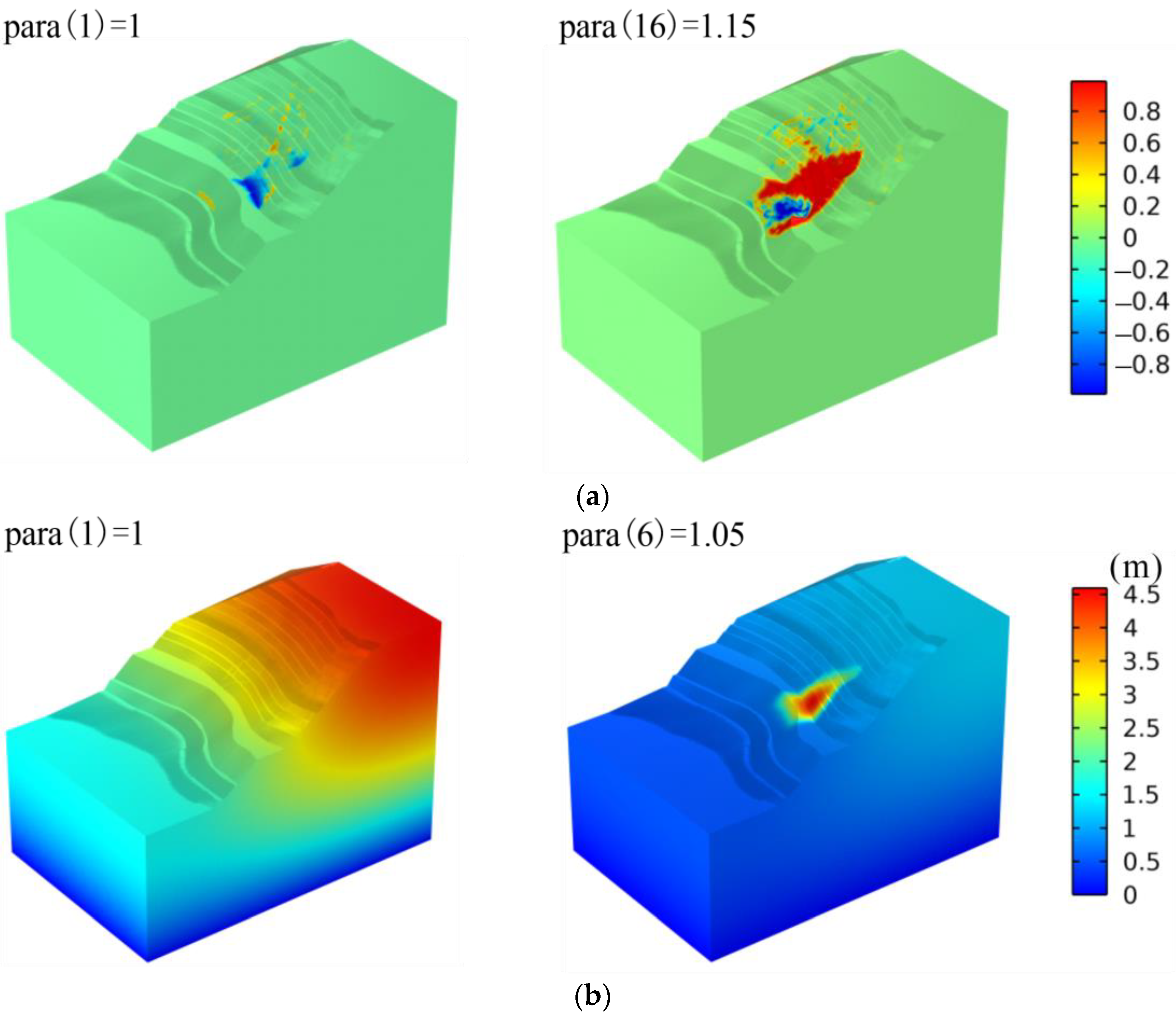

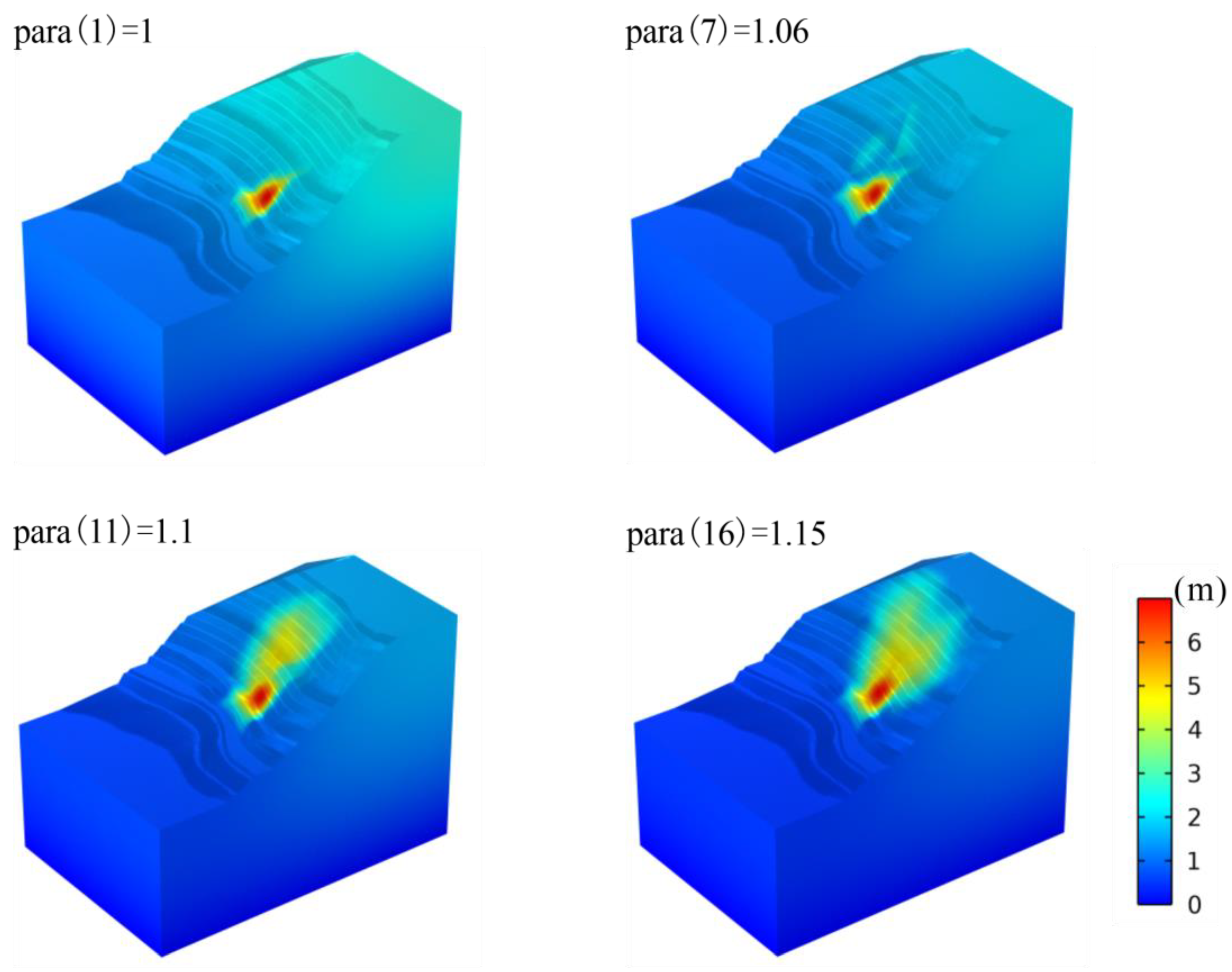


| Fault Name | F2 | F7 | F60 | Fn-1 | Fn-2 | |
|---|---|---|---|---|---|---|
| Fault attitude | Dip direction (°) | 300–305 | 302 | 30 | 160–200 | 305–315 |
| Dip angle (°) | 45–88 | 75 | 32–46 | 75–85 | 70–80 | |
| Length (m) | >1400 | 380 | 500 | 300 | 520 | |
| Lithology | Bulk Modulus (GPa) | Shear Stiffness (GPa) | Cohesion (MPa) | The Angle of Internal Friction (°) | Tensile Strength (MPa) |
|---|---|---|---|---|---|
| Mica schist | 15 | 12 | 0.6 | 37 | 0.6 |
| Chlorite schist | 7 | 7 | 0.4 | 33 | 0.4 |
| Epidote amphibolite | 5 | 3 | 0.2 | 30–33 | 0.01 |
| Two-mica quartz schist | 6 | 4 | 0.1–0.2 | 30 | 0.04 |
| Quartz granulite | 10 | 10 | 0.2 | 33 | 0.05 |
| Granite | 12 | 10 | 0.5 | 35 | 0.3 |
| Iron ore | 12 | 12 | 0.6 | 35 | 0.4 |
| Fault | 2.5 | 1.5 | 0–0.03 | 22 | 0 |
Disclaimer/Publisher’s Note: The statements, opinions and data contained in all publications are solely those of the individual author(s) and contributor(s) and not of MDPI and/or the editor(s). MDPI and/or the editor(s) disclaim responsibility for any injury to people or property resulting from any ideas, methods, instructions or products referred to in the content. |
© 2023 by the authors. Licensee MDPI, Basel, Switzerland. This article is an open access article distributed under the terms and conditions of the Creative Commons Attribution (CC BY) license (https://creativecommons.org/licenses/by/4.0/).
Share and Cite
Sun, D.; Deng, W.; Yang, T.; Li, J.; Zhao, Y. A Case Study Integrating Numerical Simulation and InSAR Monitoring to Analyze Bedding-Controlled Landslide in Nanfen Open-Pit Mine. Sustainability 2023, 15, 11158. https://doi.org/10.3390/su151411158
Sun D, Deng W, Yang T, Li J, Zhao Y. A Case Study Integrating Numerical Simulation and InSAR Monitoring to Analyze Bedding-Controlled Landslide in Nanfen Open-Pit Mine. Sustainability. 2023; 15(14):11158. https://doi.org/10.3390/su151411158
Chicago/Turabian StyleSun, Dongdong, Wenxue Deng, Tianhong Yang, Jinduo Li, and Yong Zhao. 2023. "A Case Study Integrating Numerical Simulation and InSAR Monitoring to Analyze Bedding-Controlled Landslide in Nanfen Open-Pit Mine" Sustainability 15, no. 14: 11158. https://doi.org/10.3390/su151411158
APA StyleSun, D., Deng, W., Yang, T., Li, J., & Zhao, Y. (2023). A Case Study Integrating Numerical Simulation and InSAR Monitoring to Analyze Bedding-Controlled Landslide in Nanfen Open-Pit Mine. Sustainability, 15(14), 11158. https://doi.org/10.3390/su151411158








